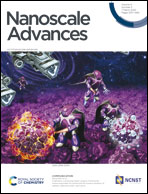Hollow carbon nanospheres embedded with stoichiometric γ-Fe2O3 and GdPO4: tuning the nanospheres for in vitro and in vivo size effect evaluation†
Abstract
The size modulation of hollow carbon nanospheres (HCSs) has attracted great interest in the contexts of cellular uptake, drug delivery and bioimaging. In this study, a facile fabrication method was specifically used to minimize all influencing factors except for the particle size. A series of nanoparticles of hollow carbon nanospheres embedded with magnetic resonance imaging (MRI) nanoagent γ-Fe2O3 and GdPO4 nanoparticles (Fe–Gd/HCS), were successfully prepared and applied to in vitro/vivo evaluation with well-defined sizes of ∼100 nm (Fe–Gd/HCS-S), ∼200 nm (Fe–Gd/HCS-M), and ∼300 nm (Fe–Gd/HCS-L), respectively. Then the in vitro size effect of Fe–Gd/HCS was systematically investigated by bio-TEM, CLSM, CCK-8 assay, and flow cytometry revealing that Fe–Gd/HCS could be internalized and the cellular uptake amounts increase with the decrease of size. Furthermore, the in vivo size-effect behavior of Fe–Gd/HCS (∼100 nm, ∼200 nm, ∼300 nm) was tracked by MRI technique, demonstrating that all Fe–Gd/HCS can distinguish the liver, in which Fe–Gd/HCS with the smallest particle size exhibited the best performance among these nanoparticles. By leveraging on these features, Fe–Gd/HCS-S (∼100 nm) was further chosen as a theranostic agent, preliminarily presenting its capability for multi-modal imaging and therapy.



 Please wait while we load your content...
Please wait while we load your content...